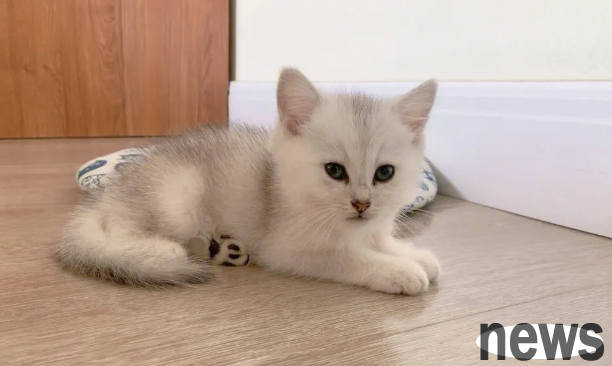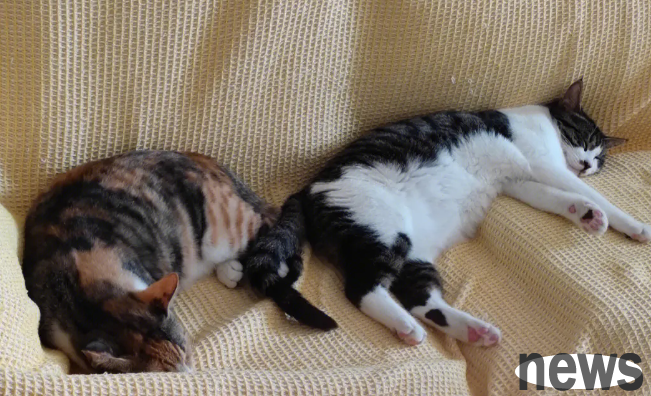When the cat shovelers are taking care of the cat, they find that the cat suddenly doesn't like to use cat litter and likes to urinate repeatedly outside the cat litter box. Some cat shovelers think that the cat is not taking good care of it. In...
When the cat shovelers are taking care of the cat, they find that the cat suddenly doesn't like to use cat litter and likes to urinate repeatedly outside the cat litter box. Some cat shovelers think that the cat is not taking good care of it. In fact, this is not the case. It is very likely that it is a red flag of the cat's lower urinary tract infection.

Lower Urinary Tract Infection:
Lower Urinary Tract Infection refers to inflammation caused by bacterial infections in the bladder, urethra and urethral opening.
Fat cat development Notes on cystitis in cats Urinary tract infection
1. Symptoms
·Frequent urination, poor urination, moaning, hematuria
·Licking the anus and genitals
·Abnormal urination behavior
·Disrestrained mentality
·Vomiting, decreased appetite
Clinical symptoms of lower urinary tract diseases of cats vary according to the disease and organs involved. For cats that have been active indoors, clinical symptoms are easier to see, while for cats who mainly live outdoors, it is not easy to observe.
2. Diagnosis
· Palpation
When palpating the posterior abdomen of a cat, if the cat does not urinate for a long time, the urethra may be completely blocked, and the abdominal wall can be felt tense
· Urine color
Normal urine is light yellow to amber due to the presence of urine pigment. The depth of the color is usually closely related to the dilution and concentration of the urine. In clinical practice, urogenital system diseases can often cause blood in the urine.
· Urine turbidity
The fresh urine of normal cats is transparent or clear, but due to the occurrence of diseases, the presence of crystals, tube types, cells, bacteria, and the pollution of external containers makes the urine turbid. The suspended particles in the urine can even be observed with the naked eye.
· Odor
In addition to the occurrence of certain diseases, the urine of cats, especially the urine of male cats, will have a characteristic irritating odor. The smell of urine has no significant significance for diagnosing the disease.
· Urine pH value
pH value is an indicator for testing urine pH. Use pH test strips to detect urine. When the pH value is less than 7.0, the urine appears acidic, and when it is greater than 7.0, it is alkaline. When measuring pH, the urine to be measured must be fresh. Drop the urine on the test strip and determine the pH of the urine according to the color mark on the pH test strip packaging.
· Abnormal behavior
such as licking the anus and genitals, abnormal urination, frequent urination, poor urination, etc.
· B-ultrasound and laboratory examination in pet hospitals
If the cat only has symptoms in the urinary tract, it is bladder-urethritis; if the cat has systemic symptoms such as hairlessness, it is a partial or complete urethral obstruction. Usually, male cats are more likely to occur than female cats, and the incidence rate is highest by castration (sterilization) of male cats and long-haired cats (especially Persian cats). Male cats are more common in urethral obstruction, while female cats are more common in cystitis and urethritis.
Causes of the disease:
· Microorganisms such as diseases or bacteria can cause infections
Tumors, trauma, bladder, umbilical urethritis, neurological disorders and other diseases can all cause inflammation of the lower urinary tract or similar symptoms of cats. Inflammation of the lower urinary tract of cats usually reduces the body's resistance and allows bacteria to grow and reproduce in large quantities in the urethra and bladder.
· Urenoint structure abnormality
The urethra structure of male cats is thin and long, among which the urethral bulbous glands and penis are the two narrowest and most prone to obstruction. The abnormal urinary tract structure of bladder diverticulum and bladder incomplete bladder development are also prone to urinary tract infections and stones. Urethral stenosis caused by scar tissue hyperplasia can also cause inflammation of the lower urinary tract of cats.
· Dietary structure and nutrition
The dietary structure of pets is unreasonable and the diet is relatively single. Frequently feeding high-protein errors can easily cause imbalance in the proportion of calcium and magnesium, which can easily form crystallization and stones; dry cat food with a large amount of fiber is difficult to digest, causing an overall increase in magnesium intake, causing stones; long-term large-scale feeding of dry cat food can cause increased feces and increased water excretion from the body through feces, resulting in a decrease in cat urination, causing increased magnesium concentration in bladder urine, causing storage in the bladder and urethra, causing stones and inflammation; failure to drink enough fresh water can also cause diseases of the lower urinary tract.
· Neurological factors
Some cats have lower urinary tract infections are caused by neural factors, such as bladder paralysis, urethral spasm, abnormal coordination of urinary tract contractile muscles, etc.
· Identical factors:
The detection of urethra catheters, irregular use of catheters, inappropriate catheter model, reuse of catheters, reverse flushing of catheters, related surgeries indwelling in the bladder and urethra, etc., cause urethra mucosal damage, urethra rupture or bacterial infection, causing urethra hyperplastic stenosis, and causing lower urinary tract diseases of cats.
· Urine pH value
The ideal measurement time for urine pH is within 4-8 hours after cat feeding. Under normal circumstances, the pH of cat urine should be maintained between 6.2-6.4. In this way, pH of urine with pH is not conducive to crystallization and stone production, thereby reducing the occurrence of lower urinary tract infection. The pH of cat urine is largely affected by cat diet. Many standard cat foods will increase after cat feeding.
· Urethral obstruction
In clinical practice, the most common causes of lower urinary tract obstruction of cats are crystallization and stones. The conditions for crystallization and stone formation include: excessive salt content in urine, long-term storage of urine, appropriate pH when salt crystallization is formed, and the decrease in the content of substances in urine that inhibit crystallization.
· Other factors
The obesity of cats makes cats lazy and unwilling to exercise, which leads to cats being unwilling to urinate and the number of times they urinate is reduced, resulting in urine storage. Some cats are prone to anxiety and dislike their dirty water basins and litter boxes, which leads to less water drinking and no urination.. In addition, castration surgery, cold weather, stress status and infresh drinking water can all become the causes of urinary tract infection in cats.
Basic treatment for families:
Conservative therapy and surgical therapy are performed according to whether the cat's lower urinary tract is blocked during treatment. Conservative therapy includes catheterization, dietary treatment, and symptomatic treatment. Usually the owner can only take dietary treatment and dosing medication.
· Dietary treatment
Change the dietary structure before onset, reduce the intake of high-protein foods, and feed various nutritious cat foods; avoid excessive intake of magnesium, phosphorus, calcium, and chlorine, and feed low-magnesium prescription foods. Control the number of feeding times, eat less and eat more meals, feed nutritional cream appropriately, encourage drinking a lot of fresh water, etc.
Note: When purchasing cat food, try to choose cat food produced by large factories. The quality is guaranteed, the packaging is exquisite, and there are specially designed and manufactured moisture-proof bags. When purchasing, please pay attention to check the nutritional content list after the packaging bag. The high-quality cat food protein content is 21%~24%, and the ingredients list is animal protein such as fish, broiler, chicken, etc., with a fat content of 8%~16%, moisture content of 10%, fiber content of 3%~4%, calcium 1.5%, phosphorus 1%
· Drug treatment
You can apply chlormycin or mycin ointment to the urethral opening and external genitals; suno (twice a day, half a tablet each time), urinary urination (once once a day, one pill every time), urination pain (twice a day, 1/4 tablet each time)
Note: If the cat is seriously infected, it is recommended to send it to the hospital for infusion and anti-inflammatory. If urethral obstruction occurs, surgical treatment should be carried out in time.

Cats are not allowed to take care of after surgery:
· Dietary care
For cases that have just finished the surgery, due to the effect of anesthesia, food can be given to you, and a small amount of water can be used to moisten your mouth. When you can feed food, it is recommended to give prescription food, eat less and eat more meals, and add some nutritional cream if necessary. Keep the drinking water fresh and sufficient. If the cat can accept wet food, soak the cat food in water and then feed it.
· Postoperative environment
After the operation, the cat's environment should be kept clean and hygienic. You can place the cat on a clean diaper. The ambient temperature is suitable. If the cat's body temperature drops, you can place the warm water bottle next to the cat. Ensure that new cat litter is replaced in time, clean and disinfect items used by cats, and do not exercise vigorously to prevent the wound from cracking.
· Drug support
In terms of promoting stone discharge, Chinese medicines such as Bazheng San can be given to prevent stones. Fossil medicine: "Jinqian Fossil Capsules": consists of monkey grass, mallow seeds, morning glory, black medicine, ashsop, sea glutinous rice, yellow cypress, chicken gizzard, rhubarb, turtle worm, licorice, etc. Take 1 pill orally / 10kg weight twice a day. Take 3 weeks for one week until you recover.
· Wound care
Cats after surgery should wear Elizabeth rings to prevent gnawing on the wound. The wound should be disinfected every day, and the wound should be kept dry after cleaning.
How parents can avoid cats being infected:
·To understand the daily life habits of sick cats, fat cats should promote more exercise and encourage cats to urinate in clean cat litter box.
· Optimize the dietary structure of cats, feed less high-protein foods, and feed prescription foods with low magnesium and acidified urine. Drinking water should be fresh and sufficient. If necessary, you can put a few more basins in the cat's favorite places.
·Cat litter should be replaced in time to ensure clean urination and defecation. The feeding environment should be kept constant to reduce unnecessary stimulation and stress caused by stress.
· Perform regular physical examinations on sick cats to ensure that problems are detected and resolved early.
Lower urinary tract infections in cats are usually caused by unreasonable dietary structure and poor living environment. Seizing the source of the disease can effectively prevent the occurrence of lower urinary tract infection.
Warm tips:
Parents can also give cats Chinese medicine for urinary tract infections, urine pain, and hematuria, which also has good therapeutic effects.
· Prescription 1:
"Bazheng San" add and subtract: 6g each of Mutong and talc (cloth bag), 3g each of Cheqianzi, Viagra, Honeysuckle, Gardenia, Forsythia, Huangqian, Rhubarb, Decoction in water and take.
· Prescription 2
"Xiaoji Yinzi" combined with "Bazheng San" add and subtract: 6g each of thistle and talc (cloth bag), 4g of fried Puhuang, 15g of fresh thirst root, 6g of raw rehmannia, 6g of radix, angelica, and licorice, decoction in water and take.
Dose method: After decocting the Chinese medicine, mix it with cat food. If the medicine tastes too strong, the cat is unwilling to take it, then give the medicine in a small amount multiple times.